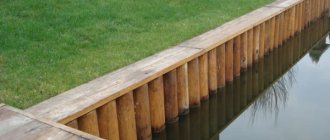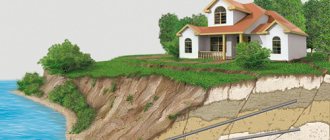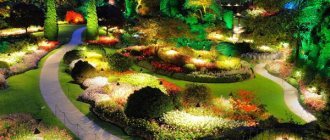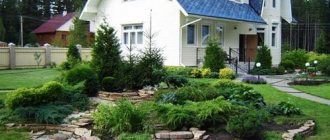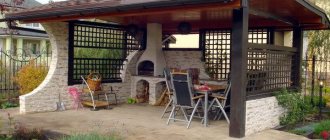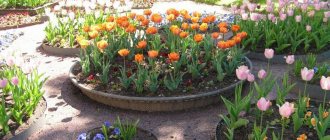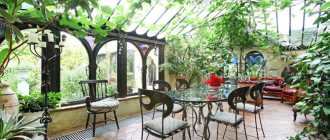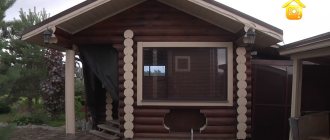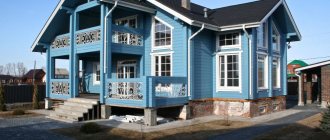No one will argue that one of the best options for transforming and decorating a summer cottage is to install an artificial pond on it. A small pond can be not only a decorative element of the aesthetic design of a plot of land, but also have practical benefits.
For example, it can be used for fish farming, swimming or as a fire tank. Each owner himself determines the purpose of his country mini-reservoir. Depending on the goals pursued by the owner, the size of the pond and options for its design and location are determined.
What types of country ponds are there?
You can choose which pond to organize in your personal plot only taking into account your needs. Most often, decorative ponds are built that enliven the garden landscape. But artificial reservoirs may have other purposes.
Decorative
Decorative is a type of pond that does not serve any practical function. Streams or fountains can be included in the composition; often the surface of the water is combined with stone banks, imitating a natural spring or lake. Ponds framed by semi-aquatic plants that grow well in moist soil look harmonious.
A small beautiful pond of this type is often located in a recreation area. It can be viewed from the veranda or gazebo. The styles of decorative ponds depend on the design of the garden.
For fish farming
Fish ponds and cages are sometimes installed on a large area. It is possible to grow fish in them only under special conditions, so this type is rarely found in a private dacha. But a dacha artificial lake can be inhabited by koi carps, goldfish or representatives of wild ichthyofauna. For the winter, the entire population of the reservoir will have to be moved to an aquarium, since small ponds in central Russia freeze to the very bottom.
In a fish hatchery you can keep purchased live fish while waiting for guests invited to fish soup.
For swimming
If the size of the plot allows, they build a full-fledged swimming pool in which you can swim while relaxing at the dacha. The linear dimensions of such a structure should be 2-3 times larger than human height, and the depth should be at least 1 m. When using a country pond for swimming, you will have to install systems for disinfection and water change. Caring for swimming pools is quite complicated.
Design
The design of an artificial reservoir will directly depend on its type and type. Based on this, it will either have strict simple forms (reservoirs) or more free outlines (ponds). In addition to the main groups of artificial water objects, there are others where the creative thoughts of the designer truly have no restrictions.
Waterfall - water falling from a height is one of the original elements of landscape design. Such a pond is an excellent solution for placement on an area with uneven terrain.
A fountain is a simple or complex structure where water shoots up or sideways from a fixed source.
Cascade is a group of small reservoirs located at different levels. The peculiarity of their design is that water from the upper level reservoir flows down through a closed system.
A mini-pond is water in a small container decorated with living plants, river pebbles and other decorative elements.
A stream is a body of water decorated to look like a natural element. It is local and fits freely into any area of the territory.
A swamp is a body of water that will look good and natural in any part of the garden and park next to a rock garden or alpine slide.
Artificial pond style
The style decision depends on the overall design of the garden. For irregular areas of various types, a pond with a design made of stone and plants that imitates natural bodies of water is suitable. In a regular garden, a well-groomed pond decorated with marble slabs or porcelain stoneware, with plants in containers, would be appropriate. Often a fountain is made in such a reservoir.
Now the design of garden plots can also include Japanese (Chinese) style. The traditional design of a pond in such a garden requires an island in the center of the lake and a path-bridge leading to it. Semi-aquatic and aquatic plants complement the pond. Carp are often put in there.
Minimalist or contemporary designs require clean geometric lines, sleek flagstone finishes and minimal vegetation. Tall grasses or reeds look harmonious.
The most beautiful decorative pond can be created in any style. When decorating it, it is only important to observe the measure in the use of stones and plants so that a small mirror of water does not get lost against the background of the frame and additional details.
Where to start for an inexperienced builder
To build an artificial lake on a site, you need to make initial measurements and calculations. But first you need to decide on the appearance of the lake, its functions, and decorative arrangements.
Where to start for an inexperienced builder:
- Determine the parameters and shape of the future reservoir, selecting the appropriate types of building material.
- It is advisable to accurately determine the decorative arrangement of the lake. You need to make a conditional sketch that indicates areas for placing plants, masonry, stones and other elements.
- Select the central composition if it will be present in the finished version. It could be a small tree, a flower bed, a garden figure, natural stone, an island with lawn grass.
Choosing a pond location
When choosing a place where a home pond will be dug, pay attention to the following criteria:
- purpose: a mini-reservoir for decoration should be accessible for inspection from several points, and it is better to hide the swimming pool from prying eyes;
- illumination: for good plant growth, insolation of about 4 hours a day is enough, and too bright or prolonged exposure to the sun will cause the water to bloom;
- distance from other objects: the pond can be used as a reservoir for irrigation water or a decorative element, and it should be located near the appropriate areas of the garden.
It is not advisable to build a pond in your dacha near buildings. If the seal is broken, moisture will saturate the soil and can damage the foundation. The distance from the house to the pit should be at least 3-4 m.
Landscape
When choosing a place to place a mini-pond in your dacha, you must also take into account the overall landscape of the garden. Natural waters collect in depressions and low-lying areas. The artificial pond will have to be placed at a lower surface to make it look more natural.
In depressions in the landscape, the groundwater level sometimes turns out to be too close to the surface. In this case, you will have to take care of strengthening and moisture-proofing the bottom and walls of the reservoir. But this location has its advantages: it is convenient to arrange cascades on a slope, imitating a running stream flowing into a lake. If the area is flat, then visual elevations of the banks will have to be created using plants of different heights, soil and stone.
It is advisable to take into account the size of the area allocated for the decorative design element. Most often, when creating a miniature lake in a dacha, the owners subsequently expand it or change the contour. Reconstruction requires free space along the banks.
Advantages and disadvantages of the foundation pit
An artificial lake requires special care, since it is often located close to the house and is purely aesthetic. To make maintenance simple and of high quality, it is worth considering an option regarding the base of the pit.
Before choosing a finishing principle, it is worth deciding on the advantages and disadvantages of each option. The advantages and disadvantages of each option are determined, which make up a comprehensive list.
The pros and cons of pit finishing options are presented in the table.
| pit | this option | presented finishes |
| The plastic garden pond is easy to install and dismantle. The container is easy to care for thanks to its smooth surface. No additional conditions are required for installation. | It is difficult to find a large size or volume. Sometimes there are difficulties with decorating. An unpleasant odor quickly develops, and algae can rot due to poor oxygen permeability. | |
| Polyethylene | Low cost. Simple installation option. The film can recreate any shapes and parameters. | Easy to damage due to mechanical impact. Water and plants quickly acquire an unpleasant odor. |
| Easy to clean and care for. Can be used for swimming. | High cost of material and labor. Requires periodic restoration. |
What materials can be used to build a pond?
The most common materials for making garden springs are containers of different sizes. By digging a large basin, bathtub, or special tank purchased in a store into the ground, you can immediately solve all problems with waterproofing the interior space. But there are other types of ponds:
- Concrete structures. They are created for a long time, because the material does not allow frequent rebuilding and reconstruction of the water tank. Concrete is impermeable and, when poured correctly, lasts for several decades. Swimming pools are made from it, tiled, but a “wild” pond will also look beautiful. To place plants in the water, you can make steps during the construction stage and camouflage the banks with stone.
- Special membranes and polyethylene. Rolled materials are not very durable and can be damaged by tools during maintenance or by plant roots. But the polyethylene film lasts for several seasons if it is protected from sunlight and the pond is cleaned carefully. Water and soil act as protection, which should cover the surface of the film as much as possible. To place plants, you will have to make steps for them when digging a pit. The film is not very convenient for swimming ponds; it will have to be changed often.
The use of other types of materials is also unlimited: a rubber tire, a wooden or tin basin, a specially welded metal container, etc. can be used as a reservoir.
Creating a pond from a tire: a guide with photos
Below we suggest that you familiarize yourself with several photos that clearly demonstrate the process of creating a reservoir from an ordinary rubber tire. We will not describe it step by step - each photograph clearly demonstrates what needs to be done and in what sequence.
Deciding on the sizes
It is not recommended to make the pond on the site too large. The dimensions of its mirror should not exceed 3% of the total area of the site. With large dimensions, the design element is difficult to fit into the landscape.
The depth is chosen arbitrarily. When designing, it is important to divide the total depth into 3 zones:
- the bottom, which occupies most of the pit area;
- tiers-steps for installing containers with non-wintering plants;
- pit for wintering plants or fish.
The depth of the pit should reach at least 1.6-1.8 m and exceed the freezing depth of the soil. This part can occupy no more than 5% of the bottom area. In small ponds, pits are not dug.
When using polyethylene, the dimensions will have to be tied to its width. The maximum size of the lake according to one of the measurements cannot exceed 6 m, but double the depth (height of the sides) must also be subtracted from this value.
Plan and calculations
Before you make a pond with your own hands, you need to draw a sketch, indicating the approximate shape and location of the water mirror. Based on the sketch, a drawing is made indicating the location and width of the tiers. Having determined the bottom profile, you can calculate the required amount of film or concrete.
When making calculations, it is important to take into account not only the area of the mirror and the bottom, but also the height of the sides of the pit, the width of each tier, and all additional unevenness of the underwater part of the relief. When concreting the bowl, the screed is reinforced with reinforcing mesh. Calculations will have to be made for it too. Concrete calculations are made taking into account the thickness of the screed (at least 5-7 cm). In a large pond, it is necessary to consider a water drainage system.
Classification
A reservoir of unnatural origin is a stable or temporary accumulation of water in an artificial lowland. The water in it has no movement, or there is barely noticeable movement. Depending on the topography of the territory and the purpose of the water body, its external shape, the outline of the coastline, depth and width may be different. Based on the same factors, power can be provided through surface runoff, a pumping unit, groundwater, and a combination.
Reservoirs are classified:
- by design characteristics (combined, dam reservoirs, dug, small);
- by purpose (multifunctional, household, sports, decorative, recreational);
- by location (in excavations, slopes, river beds, floodplains, watersheds and others).
In total, there are three main groups of artificial reservoirs: reservoirs (volume from 1 million cubic meters), ponds (volume no more than 1 million cubic meters) and pools, which are characterized by full regulation of the water regime and isolation from the external environment.
We prepare equipment and tools
To independently arrange a pond at your dacha, you do not need complex equipment. The main tool is a shovel, which will need to dig a hole sufficient to deepen the finished container. The pit for a more complex configuration, but small pond, is also dug manually, forming elements of the bottom topography.
In addition to the shovel, you will need:
- material for waterproofing (finished container, concrete or film);
- pipes for filling and creating a running stream (in a closed system - a pump);
- reinforcement mesh for concrete and metal shears;
- fine sand;
- decor for finishing edges, bottom, sides;
- measuring instruments.
Prices for the construction of ponds and reservoirs
| Titles of works | Unit. | Price in rub. |
| Soil development using machinery | m3 | from 500 |
| Manual soil development | m3 | from 1200 |
| Tamping the base | m2 | from 100 |
| Strengthening the banks with piles | m2 | from 1100 |
| Strengthening the banks with sheet piling | m2 | from 1200 |
| Strengthening the banks with geogrid | m2 | from 600 |
| Pond membrane installation | m2 | from 400 |
| Waterproofing device | m2 | from 400 |
| Concreting | m2 | from 990 |
| Application of polyurethane waterproofing | m2 | from 400 |
| Installation of treatment equipment | comp. | from 25000 |
| Construction of a shoreline made of pebbles | m3 | from 800 |
| Sand coastline construction | m3 | from 800 |
| Planting pond plants | m2 | from 200 |
The prices indicated above are preliminary, since the final price of construction depends, among other things, on the complexity of the specific project and its features. In addition to the above prices in our price list, there are many more works that are not included in this price table, for example, various forms of decoration, installation of wastewater treatment plants, planting pond plants, etc... To get an exact price for work and materials, you can Contact our estimate department by email - or order an engineer to visit your site to take measurements and consult.
Online cost calculator for building an artificial pond
Click to open the calculator and calculate the cost
Calculation of the cost of building a pond or reservoir
We create an artificial pond
When everything is prepared, you can proceed to construction work. In the selected area, remove the turf and carefully fold it: it can be useful for finishing. You can mark the contours of the coastline and bottom relief with pegs and cords. At this stage it is convenient to make changes to the outline of the banks and the location of aquatic plants.
Digging a pit
The arrangement of the pond begins with the deepest areas, digging them along the contour of the shelves to accommodate plants. After this, part of the soil is removed from more elevated areas, moving in the same way - from the lowest to the highest. Their contours are finally formed and the surfaces are leveled.
A layer of sand about 3 cm thick is applied to all horizontal lines. It will protect the film from damage by pebbles, hard pieces of soil, etc. If you choose the method of making a decorative pond from film, then all that remains is to spread the membrane, pressing it against the uneven terrain. To create a mini-reservoir, you need to choose the thickest black film.
When using concrete, the screed is carefully applied to all walls and horizontals, and then reinforced with mesh and another concrete layer is made. The finished bowl will gain strength within 21 days. After this, you can fill the pool.
We construct or install a ready-made container
To install the finished container proceed in a similar way. Measure a complex-shaped purchased bowl, determining the relief. The contours can be traced right on the spot by turning the tank over. After this, the soil is excavated taking into account the shape of the container and installed, correcting the defects.
Features of the finished tank arrangement
The artificial lake is finished in accordance with the functional features of use. To do this, first prepare a decoration layout, and then select materials.
It is easier to decorate a garden plastic pond on its banks. You can recreate a sandy beach with stone decoration elements. A variety of flowers and cultivated watery plants will add appropriate color.
In the middle of the reservoir you can install a pedestal on which some figurine, an amphora, or an island with plants will rise. The bottom can be covered with pebbles, pebbles, sand.
A popular option is to place a recreation area near a pond. Various types of gazebos, sun loungers, garden tables with chairs, and rocking chairs are installed. It is worth setting up an entertainment area for children: slides, trampoline, inflatable toys for swimming. You can combine several arrangement options at once.
A self-created decorative artificial lake will help complete the landscape of a suburban area and make it attractive and cozy. Admiring the surface of the water, it will be pleasant to relax after a hectic day and enjoy the coolness in the summer heat. If desired, anyone can build and decorate a man-made country pond. An exciting activity will bring pleasure and benefit the family, and fatigue will be pleasant if you approach the matter creatively.
We design an artificial pond
The easiest way to decorate a small pond is to line it along the contour with decorative stones or mask the edge of the container with turf and soil. A large pond made of film with a stone lining of the shore will need to be lined with flagstone along all sides, starting from the bottom and gradually raising the masonry to the level of the banks. This will protect the film from the sun and prevent it from swelling into bubbles under water. You can pour pebbles or river sand at the bottom, lay rounded stones or remnants of flagstone.
The banks are decorated with stone blocks. If necessary, arrange a cascade of waterfalls from stone tiles. The decor should completely mask the film or sides of the containers, water pipes, electrical wiring (for lighting, pump, etc.).
Plants and additional accessories
Pond design most often requires planting plants on the shore and in the water column. Local winter-hardy semi-aquatic grasses and shrubs are planted on the shore, arranging clumps in accordance with their design. It is more convenient to plant aquatic ones in shallow plastic containers and place them on shelves so that the edges of the containers are under water. During the summer, indoor plants that naturally lead a semi-aquatic lifestyle can be brought into ponds in the garden: cyperus, spathiphyllum, etc. They will give the pond an unusual look.
Additional accessories may include decorative garden figures. You can also make them yourself. The theme of such products should be related to water: it could be frogs, herons, turtles, etc.
What can a water tank be made from?
The hardest work physically is digging a pit. The second problem arises at the time of finishing the pit. If the bottom and walls are not finished in a special way, the lake will become covered with silt, it will smell unpleasant, and the walls will begin to slide over time.
The pond bowl can be made from the following materials:
- Plastic container for special purposes. You can make the container yourself from plastic containers.
- The simplest option is to cover the bottom of the pit with plastic film, and then finish the polyethylene with other building materials.
- You can make the base like a swimming pool. Concrete the pit and then cover it with tiles or tiles. Cover the bottom with gravel or crushed stone.
These are the most common options for forming a pit. Sometimes more complex finishing methods are used. Some projects use all the presented methods simultaneously.
